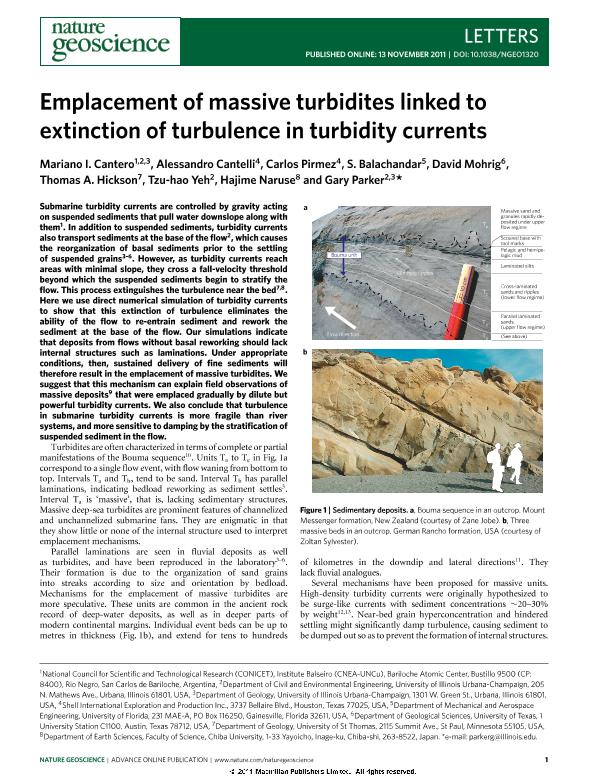Artículo
Emplacement of massive turbidites linked to extinction of turbulence in turbidity currents
Cantero, Mariano Ignacio ; Cantelli, Alessandro; Pirmez, Carlos; Balachandar, S.; Mohrig, David; Hickson, Thomas; Yeh, Tzu-hao; Naruse, Hajime; Parker, Gary
; Cantelli, Alessandro; Pirmez, Carlos; Balachandar, S.; Mohrig, David; Hickson, Thomas; Yeh, Tzu-hao; Naruse, Hajime; Parker, Gary
 ; Cantelli, Alessandro; Pirmez, Carlos; Balachandar, S.; Mohrig, David; Hickson, Thomas; Yeh, Tzu-hao; Naruse, Hajime; Parker, Gary
; Cantelli, Alessandro; Pirmez, Carlos; Balachandar, S.; Mohrig, David; Hickson, Thomas; Yeh, Tzu-hao; Naruse, Hajime; Parker, Gary
Fecha de publicación:
01/2012
Editorial:
Nature Publishing Group
Revista:
Nature Geoscience
ISSN:
1752-0894
Idioma:
Inglés
Tipo de recurso:
Artículo publicado
Clasificación temática:
Resumen
Unlike river systems which are controlled by the gravitational pull of water, submarine turbidity currents are controlled by the gravitational pull of suspended sediments. The suspended sediments in turn pull water downslope along with them. Turbidity currents also transport sediments at the base of the flow, which causes the reorganization of basal sediments prior to the settling of suspended grains. However, as turbidity currents reach areas with minimal slope, they cross a threshold beyond which the suspended sediments begin to stratify the flow. This process extinguishes the turbulence near the bed. Here we use direct numerical simulation (DNS) to show that this extinction of turbulence eliminates the ability of the flow to re-entrain sediment and rework the sediment in the bed of the flow. Our simulations indicate that the lack of reworking at the base of the flow leads to deposits that lack internal structures such as laminations. Sustained delivery of suspended sediments will therefore result in the emplacement of massive turbidites. We suggest that this mechanism can explain field observations of massive deposits that were emplaced gradually by dilute but powerful turbidity currents. We also conclude that turbulence in submarine turbidity currents is more fragile than that of river systems, and more sensitive to damping by the stratification of suspended sediment in the flow.
Palabras clave:
Turbidity Currents
,
Sedimentary Deposits
,
Direct Numerical Simulation
Archivos asociados
Licencia
Identificadores
Colecciones
Articulos(CCT - PATAGONIA NORTE)
Articulos de CTRO.CIENTIFICO TECNOL.CONICET - PATAGONIA NORTE
Articulos de CTRO.CIENTIFICO TECNOL.CONICET - PATAGONIA NORTE
Citación
Cantero, Mariano Ignacio; Cantelli, Alessandro; Pirmez, Carlos; Balachandar, S.; Mohrig, David; et al.; Emplacement of massive turbidites linked to extinction of turbulence in turbidity currents; Nature Publishing Group; Nature Geoscience; 5; 1-2012; 42-45
Compartir
Altmétricas



